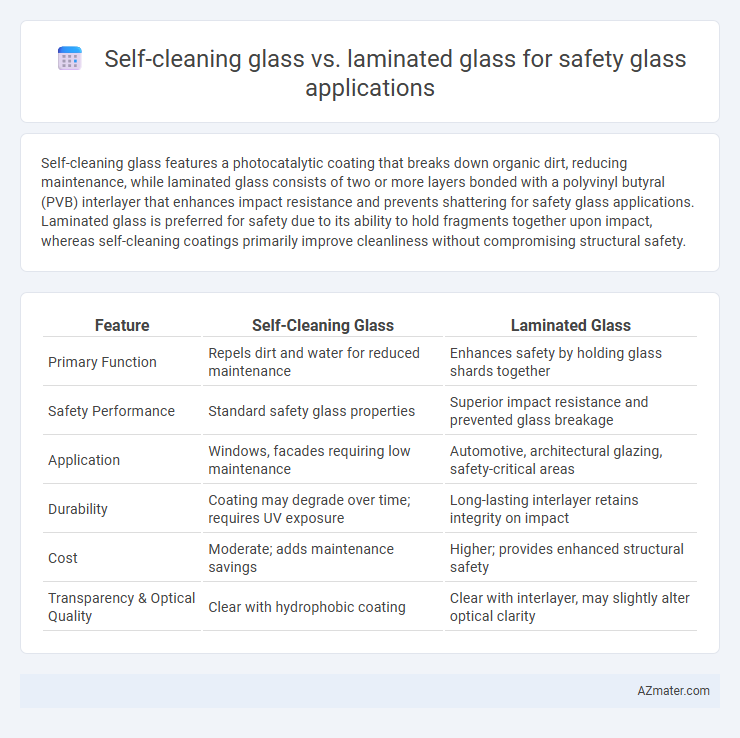Self-cleaning glass features a photocatalytic coating that breaks down organic dirt, reducing maintenance, while laminated glass consists of two or more layers bonded with a polyvinyl butyral (PVB) interlayer that enhances impact resistance and prevents shattering for safety glass applications. Laminated glass is preferred for safety due to its ability to hold fragments together upon impact, whereas self-cleaning coatings primarily improve cleanliness without compromising structural safety.
Table of Comparison
| Feature | Self-Cleaning Glass | Laminated Glass |
|---|---|---|
| Primary Function | Repels dirt and water for reduced maintenance | Enhances safety by holding glass shards together |
| Safety Performance | Standard safety glass properties | Superior impact resistance and prevented glass breakage |
| Application | Windows, facades requiring low maintenance | Automotive, architectural glazing, safety-critical areas |
| Durability | Coating may degrade over time; requires UV exposure | Long-lasting interlayer retains integrity on impact |
| Cost | Moderate; adds maintenance savings | Higher; provides enhanced structural safety |
| Transparency & Optical Quality | Clear with hydrophobic coating | Clear with interlayer, may slightly alter optical clarity |
Introduction to Safety Glass Applications
Safety glass applications prioritize materials that enhance both protection and durability, with self-cleaning glass and laminated glass serving distinct roles. Laminated glass offers superior impact resistance and prevents shattering by holding glass fragments together, making it ideal for automotive windshields and building facades. Self-cleaning glass, coated with titanium dioxide, reduces maintenance by breaking down organic dirt, appealing to architectural uses where cleanliness and safety are both critical.
What is Self-Cleaning Glass?
Self-cleaning glass features a special photocatalytic coating that utilizes sunlight to break down organic dirt and rain to wash away debris, reducing maintenance efforts. Primarily used in safety glass applications for facades and windows, it ensures clearer visibility and enhanced durability against environmental pollutants. Compared to laminated glass, which offers superior impact resistance by bonding layers for shatterproof safety, self-cleaning glass emphasizes cleanliness and low upkeep while maintaining essential safety standards.
What is Laminated Glass?
Laminated glass consists of two or more glass layers bonded together by an interlayer, typically polyvinyl butyral (PVB), providing enhanced safety by holding the glass fragments in place upon impact. Unlike self-cleaning glass, which features a special coating to reduce dirt accumulation, laminated glass prioritizes structural integrity and protection against breakage, making it ideal for safety glass applications in vehicles, skylights, and facades. Its ability to absorb shocks and resist penetration helps prevent injuries, contributing to building security and occupant safety.
Key Features of Self-Cleaning Glass
Self-cleaning glass features a special titanium dioxide coating that breaks down organic dirt using natural sunlight and allows rainwater to wash it away, reducing maintenance efforts significantly. This glass enhances safety by maintaining clear visibility, preventing the buildup of grime that could obscure vision and compromise security in safety glass applications. Compared to laminated glass, which primarily focuses on impact resistance and shatter protection through interlayer bonding, self-cleaning glass emphasizes cleanliness and durability in environments prone to dirt and pollutants.
Key Features of Laminated Glass
Laminated glass consists of two or more glass layers bonded with an interlayer, enhancing its impact resistance and safety performance by preventing shattering upon breakage. This type of safety glass provides superior protection against forced entry, UV radiation, and noise infiltration, making it ideal for security and architectural applications. Its durability and ability to maintain integrity under stress distinguish laminated glass from self-cleaning glass, which primarily focuses on surface cleanliness rather than structural safety.
Safety Performance: Self-Cleaning vs Laminated Glass
Self-cleaning glass incorporates a photocatalytic coating that breaks down organic dirt and water spots, maintaining clarity but offering limited impact resistance compared to laminated glass. Laminated glass consists of two or more glass layers bonded with an interlayer, providing superior safety performance by preventing shattering and reducing injury risk during impact. In safety glass applications, laminated glass outperforms self-cleaning glass due to its enhanced structural integrity and ability to hold fragments together upon breakage.
Durability and Maintenance Comparison
Self-cleaning glass utilizes a special coating that breaks down organic dirt and repels water, significantly reducing maintenance needs compared to laminated glass, which requires manual cleaning to maintain clarity. Laminated glass excels in durability by combining layers of glass and a plastic interlayer, providing superior impact resistance and safety performance in case of breakage. While self-cleaning glass offers low maintenance benefits, laminated glass offers enhanced protection and longevity under high-impact conditions, making the choice dependent on application priorities.
Cost Analysis: Self-Cleaning vs Laminated Glass
Self-cleaning glass typically incurs higher initial costs due to its advanced photocatalytic coatings but can reduce long-term maintenance expenses by minimizing cleaning frequency. Laminated glass, while generally less expensive upfront, offers superior impact resistance and safety benefits, potentially lowering repair and replacement costs after incidents. Cost analysis should weigh the balance between higher upfront investment in self-cleaning technology and the enhanced durability and safety performance of laminated glass.
Suitability for Different Environments
Self-cleaning glass suits environments prone to dirt and pollution, such as urban buildings, by reducing maintenance needs through its photocatalytic and hydrophilic coatings that break down organic dirt. Laminated glass excels in safety-critical applications like schools, hospitals, and vehicles, offering strong impact resistance and holding shattered fragments together to prevent injury. Choosing between these depends on balancing environmental exposure with safety requirements, as self-cleaning glass optimizes cleanliness and laminated glass prioritizes structural protection.
Conclusion: Choosing the Right Safety Glass
Self-cleaning glass offers the advantage of reduced maintenance by utilizing a hydrophilic coating that breaks down organic dirt, making it ideal for hard-to-reach or exterior applications. Laminated glass, composed of two or more glass layers bonded with a polyvinyl butyral (PVB) interlayer, provides superior impact resistance and enhanced safety by preventing shattering. Selecting the right safety glass depends on application requirements: choose laminated glass for maximum protection against breakage and self-cleaning glass for convenience and reduced upkeep, especially in environments where cleanliness and visibility are crucial.

Infographic: Self-cleaning glass vs Laminated glass for Safety glass application
 azmater.com
azmater.com